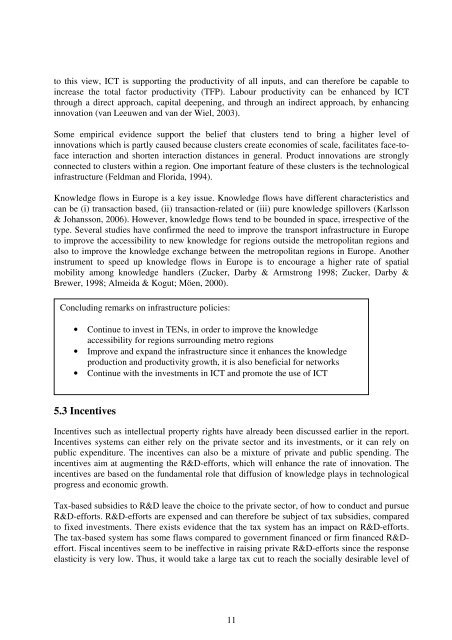INNOVATION POLICY INSTRUMENTS
INNOVATION POLICY INSTRUMENTS
INNOVATION POLICY INSTRUMENTS
Create successful ePaper yourself
Turn your PDF publications into a flip-book with our unique Google optimized e-Paper software.
to this view, ICT is supporting the productivity of all inputs, and can therefore be capable to<br />
increase the total factor productivity (TFP). Labour productivity can be enhanced by ICT<br />
through a direct approach, capital deepening, and through an indirect approach, by enhancing<br />
innovation (van Leeuwen and van der Wiel, 2003).<br />
Some empirical evidence support the belief that clusters tend to bring a higher level of<br />
innovations which is partly caused because clusters create economies of scale, facilitates face-toface<br />
interaction and shorten interaction distances in general. Product innovations are strongly<br />
connected to clusters within a region. One important feature of these clusters is the technological<br />
infrastructure (Feldman and Florida, 1994).<br />
Knowledge flows in Europe is a key issue. Knowledge flows have different characteristics and<br />
can be (i) transaction based, (ii) transaction-related or (iii) pure knowledge spillovers (Karlsson<br />
& Johansson, 2006). However, knowledge flows tend to be bounded in space, irrespective of the<br />
type. Several studies have confirmed the need to improve the transport infrastructure in Europe<br />
to improve the accessibility to new knowledge for regions outside the metropolitan regions and<br />
also to improve the knowledge exchange between the metropolitan regions in Europe. Another<br />
instrument to speed up knowledge flows in Europe is to encourage a higher rate of spatial<br />
mobility among knowledge handlers (Zucker, Darby & Armstrong 1998; Zucker, Darby &<br />
Brewer, 1998; Almeida & Kogut; Möen, 2000).<br />
Concluding remarks on infrastructure policies:<br />
• Continue to invest in TENs, in order to improve the knowledge<br />
accessibility for regions surrounding metro regions<br />
• Improve and expand the infrastructure since it enhances the knowledge<br />
production and productivity growth, it is also beneficial for networks<br />
• Continue with the investments in ICT and promote the use of ICT<br />
5.3 Incentives<br />
Incentives such as intellectual property rights have already been discussed earlier in the report.<br />
Incentives systems can either rely on the private sector and its investments, or it can rely on<br />
public expenditure. The incentives can also be a mixture of private and public spending. The<br />
incentives aim at augmenting the R&D-efforts, which will enhance the rate of innovation. The<br />
incentives are based on the fundamental role that diffusion of knowledge plays in technological<br />
progress and economic growth.<br />
Tax-based subsidies to R&D leave the choice to the private sector, of how to conduct and pursue<br />
R&D-efforts. R&D-efforts are expensed and can therefore be subject of tax subsidies, compared<br />
to fixed investments. There exists evidence that the tax system has an impact on R&D-efforts.<br />
The tax-based system has some flaws compared to government financed or firm financed R&Deffort.<br />
Fiscal incentives seem to be ineffective in raising private R&D-efforts since the response<br />
elasticity is very low. Thus, it would take a large tax cut to reach the socially desirable level of<br />
11
















